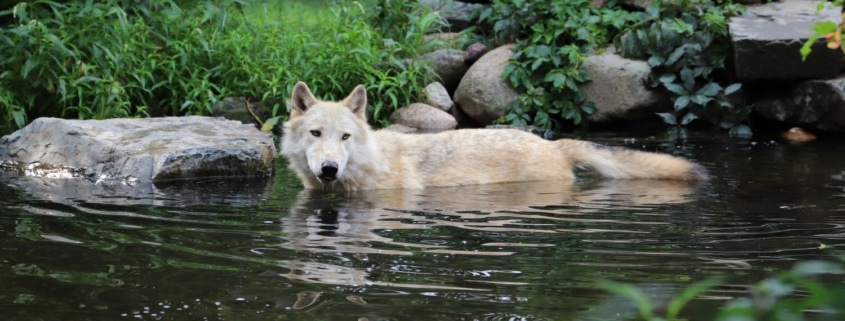Exhibit Pack Update – 18 August 2024
Wolf activity in the Exhibit Pack has lessened in the past few weeks due to some increased temperatures. During a hot day, a wolf is more likely to rest someplace it can cool off such as in the shade of a forest, in a dugout dirt hole, or possibly even in a den. The bugs have decreased significantly, with the arrival of August, meaning that the woods has become a comfortable place of respite from the heat once more; our ambassadors still utilize the many shaded areas by the viewing windows, but they may retreat to the treeline during the hottest part of the day. If you are planning on visiting our interpretive facility to see the Exhibit Pack this month, we recommend you arrive early or late in the day, when pack activity is at its highest. We still offer enrichment at noon and 4pm everyday, making these excellent times to visit the wolves.
Caz (pictured above) is already growing in his undercoat in preparation for this coming winter. In order to cool off with this extra fur, he can often be seen swimming a lap around the pond.
Fur growth and shedding appears to differ year by year (and wolf by wolf!), indicating that there is more to it than just a change in photoperiod or temperature. Hormones play a large role in the behavior and physiology of wolves; Prolactin is one of these key hormones that influence both behavior and physiology. It is thought that the production of prolactin (in association with other hormones such as melatonin) may be associated with coat shedding and regrowth (Martinet et al. 1984). While prolactin production is influenced by photoperiod, individual wolves may vary on the rate and amount of prolactin produced, thus resulting in a variation of behavioral and physiological effects. See the following passage from Wolves: Behavior, Ecology, and Conservation:
“Wolves shed their thick, insulating undercoat in spring as day length and PRL [prolactin] concentration increase. Conversely, in fall, when day length and PRL decrease, the summer coat is replaced by the thick winter pelage. Any reproductive or pelage effects that PRL may have, however, are most likely a function of a complex relationship with several other hormones such as melatonin. Since melatonin is also highly photoperiodic, it could be acting as a primary messenger mediating the effect of photoperiodicity on season events, in which PRL acts as a modulating, secondary messenger (Bubenik et al. 1986).” – Terry J. Kreeger; edited by L. David Mech and Luigi Boitani 2003
So while Caz is beginning his winter coat regrowth, his brother Blackstone is still very much enjoying his summer coat! This is a great example of the individuality of wolves more than just personality, but also the individuality of physiology.




